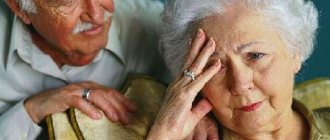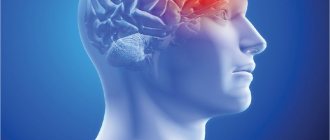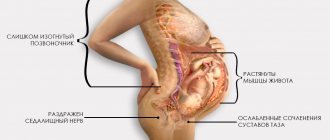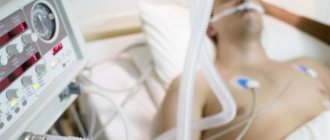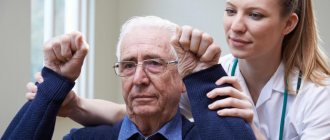In percentage terms, a large proportion of bedridden patients are elderly people. This is due to the fact that the aging body is most susceptible to various diseases, since the immune system is no longer able to fully cope with its task. Time itself also plays a big role - over the years, the human body simply wears out.
Elderly bedridden patients require special care, and to provide it, you need to know not only the basic rules of care, but also the reasons why an elderly person is bedridden.
Diseases that cause disability in older people
Most often, it is not age itself that leads to disability in older people, but concomitant chronic diseases, which become more and more severe over the years. Such diseases can occur in a person of mature age, and sometimes they appear in adolescence or even from birth. A strong young body is able to fight the problem without allowing it to manifest itself, but over the years the disease takes over and leads to serious consequences.
There are a number of diseases that are more likely to lead to disability in an elderly person:
- disruption of the circulatory system;
- malignant tumors;
- damage to the nervous system;
- damage to the musculoskeletal system;
- damage to the respiratory system.
Let's take a closer look at these factors.
How to increase the period
To maintain mental health and increase your life expectancy with dementia, you need to walk and exercise a lot, as well as regularly train your brain with intellectual exercises.
In addition, a balanced diet will help in the fight against dementia.
Patients are advised to follow a proper balanced diet, including foods rich in vitamins and natural antioxidants.
If the onset of dementia is diagnosed at a young age and at an early stage, doctors have a chance to cure the patient, while in old age the process is irreversible.
Unfortunately, there is no effective way to get rid of dementia that occurs against the background of various diseases.
However, with the help of a timely response to the emerging symptoms of the disease and well-chosen drug therapy, it is possible to slow down the rapid development of a mental disorder, extending a person’s life to 10 and sometimes 20 years.
Circulatory system
Diseases of the circulatory system are not in vain in the first place. It is in old age that significant changes in blood vessels begin to occur in the human body. Such changes only lead to a worsening of the situation: the tissues of the vessel walls become thinner, losing their integral structure and elasticity; in addition, seals appear inside the vessel, interfering with blood circulation. This increases the risk of blood clots.
The affected vessel can no longer fully narrow or expand. All this leads to an increase in arterial pressure and a decrease in venous pressure.
At this age, the cardiac output also decreases. In this regard, restructuring begins within the circulatory system, since other systems lack the amount of nutrients delivered by the blood. This causes the body to spend more energy on the heart.
The heart muscle itself also ages: muscle tissue atrophies and weakens, myocardial sclerosis progresses.
Recommendations for bedridden patients
It must be remembered that bed rest is prescribed for a specific time period. It is necessary to maintain motor restrictions until the dangerous symptoms disappear (sometimes you have to wait for test results to improve).
Maintaining bed rest as a precaution is not recommended, but it is necessary to gradually exit it. Doctors advise starting with bed exercises; After a certain period of time, you can try to stand on the floor.
When getting out of bed, you need to follow certain rules. They look like this. While on your back, you need to put your hands on your stomach and take several smooth breaths (exhalations are also done smoothly). As you inhale, you need to tense your abdominal muscles and protrude your stomach as much as possible; On exhalation, the stomach, on the contrary, retracts. While performing these steps, you can slightly bend your legs. A total of 15 breaths are recommended. Then you should stretch your arms up and your heels down. After this, you need to roll over onto your stomach, lean on your elbows and knees, and at the end bend over like a cat. That's it, you can get up. It is recommended to do this carefully, leaning on your elbows.
Doctors categorically prohibit impulsive standing up. This warning is due to the fact that prolonged lying down worsens vascular tone. A sudden change in body position when standing up can disrupt blood pressure (in particular, lower it). Sometimes such bold attempts end in fainting.
Malignant formations
Also a common cause of disability. Malignant tumors may differ in men and women.
In men, most often it is a prostate tumor (more than 30%), lung damage (about 14%), malignant tumors in the rectum (10%), melanoma (about 5%).
In women, the most vulnerable place is the mammary gland (more than 30%), further percentages differ slightly from men.
One way or another, the most dangerous malignant tumors, leading to disability or death, are located in the lungs.
Nervous system
As years pass and old age approaches, not all people remain sane. General atrophy of the body affects the nervous system, and then the consequences can be very serious. Atrophy of the nervous system leads to dementia, Alzheimer's or Parkinson's disease.
The most common occurrence is memory loss, which can lead to complete loss. At the same time, the elderly person loses the ability to perform the most basic automated actions (the person forgets how to dress, brush his teeth, wash his face and eat). This always leads to the patient becoming bedridden.
Other patients may lose intelligible speech and the ability to read and write. In the thermal stage, insanity manifests itself: mental attacks, convulsions, uncontrollable laughter or crying, hysteria, severe panic attacks.
Lots of problems
But even spending a relatively short time in a hospital bed without the opportunity to take at least a few steps is also dangerous. That is why surgeons force operated patients to get up almost immediately after the anesthesia wears off. Well, at least for the next day, for sure.
Among the harmful effects of prolonged lying: body numbness, joint stiffness, muscle atrophy. It is estimated that in complete rest a person loses up to 3% of total muscle mass per day. That is, after just a month or so of incessant horizontal rest, complete muscle atrophy can occur and a person simply cannot take a single step on his own.
In addition, prolonged bed rest can lead to a decrease in the functions of the cardiovascular system, the risk of thrombosis, and therefore pulmonary embolism, which threatens the patient with sudden death.
Article on the topic
It is forbidden to stand up. How to care for a bedridden patient
Musculoskeletal system
Diseases of this system often leave the patient bedridden, but at the same time he remains lucid, limited only in physical activities.
Atrophy of muscle tissue, damage to joints and tendons can cause severe discomfort in everyday life, and can lead to a complete loss of control over movement of body parts.
The most severe disease is coxarthrosis, which occurs in the hip joint. A person with this disease is likely to lose the ability to move.
Also, tissue damage can occur in the knee joints, spine, hands and other joints throughout the body.
Signs of approaching death
Signs of death in a bedridden patient may be different in each case. There are several main ones:
- Loss of appetite. The patient's body requires less and less energy to maintain vital functions. The person does not drink, refuses to eat, or eats small amounts of soft foods (for example, porridge). Sometimes meat is rejected first because it is difficult to digest. Just before death, the patient may lose the ability to swallow.
How should family and friends react to this behavior? If a bedridden patient does not eat or drink, there is no need to force him to do so. You can periodically offer cold water and ice cream. To prevent your lips from drying out, moisten them with a damp cloth or special balm.
- Increased fatigue and drowsiness. If a bedridden person sleeps a lot, this means that his metabolism has slowed down and dehydration has occurred due to a reduction in fluid and food intake. Fatigue is very pronounced, the patient is sometimes unable to determine the boundary between sleep and reality.
What to do? Give the patient plenty of sleep. Don't push him to try to wake him up. If you say something to a person, it is quite possible that they will hear it, as it is believed that patients can hear even in a coma.
- Severe weakness. Due to low calorie intake, the patient does not have enough energy to even lift his head or roll over in bed. Therefore, caregivers need to provide comfortable conditions for the person lying down.
- Disorientation and confusion. These signs of the patient’s imminent death occur because the patient’s vital organs, including the brain, begin to work worse. Consciousness begins to change, a person can see strangers in the room (although they are not there), and say strange things. You need to remain calm and call yourself by name when communicating with the patient, as he may not recognize you.
- Breathing disorders. It becomes difficult for the patient to breathe. The so-called Cheyne-Stokes breathing may be observed, a condition in which rare and superficial respiratory movements begin to deepen and become more frequent, and after 5-7 inhalations they again slow down and weaken. Then there is a pause. Signs of death in a bedridden patient after a stroke often include death rattles caused by the accumulation of saliva and secretions from the lungs (these symptoms are not usually seen in cancer patients). How to help a patient in such cases? Just lift his head and place a pillow under it. You can also sit the person down and fix the position of the body. It is recommended to moisturize your lips.
- Closedness. When life processes fade away, the dying person may lose interest in others. He constantly sleeps, does not speak, or stops answering questions and turns away. Keep in mind that this is a sign of the dying process, and not a reflection of the patient's attitude towards you. Be close to him, take his hand (if the person allows) and talk, even if this speech is a monologue.
- Urinary disorders. Because the person eats and drinks little, urination is rare. They have a reddish or brownish tint as kidney function deteriorates. Sometimes the patient does not control the process of urination.
- Edema. Due to impaired kidney function, fluid accumulates in the body and swelling occurs (especially in the legs).
- Reduced blood pressure. Signs of death from old age include a sharp drop in blood pressure (systolic below 70, diastolic below 50).
- Cold fingers and toes. Before death, blood moves from the periphery to the center to help vital organs. To ensure comfort, you can cover the patient.
- Venous spots. They arise due to deterioration of blood circulation in the body.
Certain diseases cause specific symptoms. Thus, signs of death in a cancer patient often manifest themselves in the form of pain, nausea, confusion, anxiety and shortness of breath (with a stroke, such symptoms are less common).
It should also be noted that low blood pressure or prolonged cessation of respiratory movements (or if the bedridden patient is constantly sleeping) are not reliable indicators of imminent death in all cases. Some patients with these symptoms may suddenly recover and survive for a week, a month, or even more. Only God knows when death will occur.
